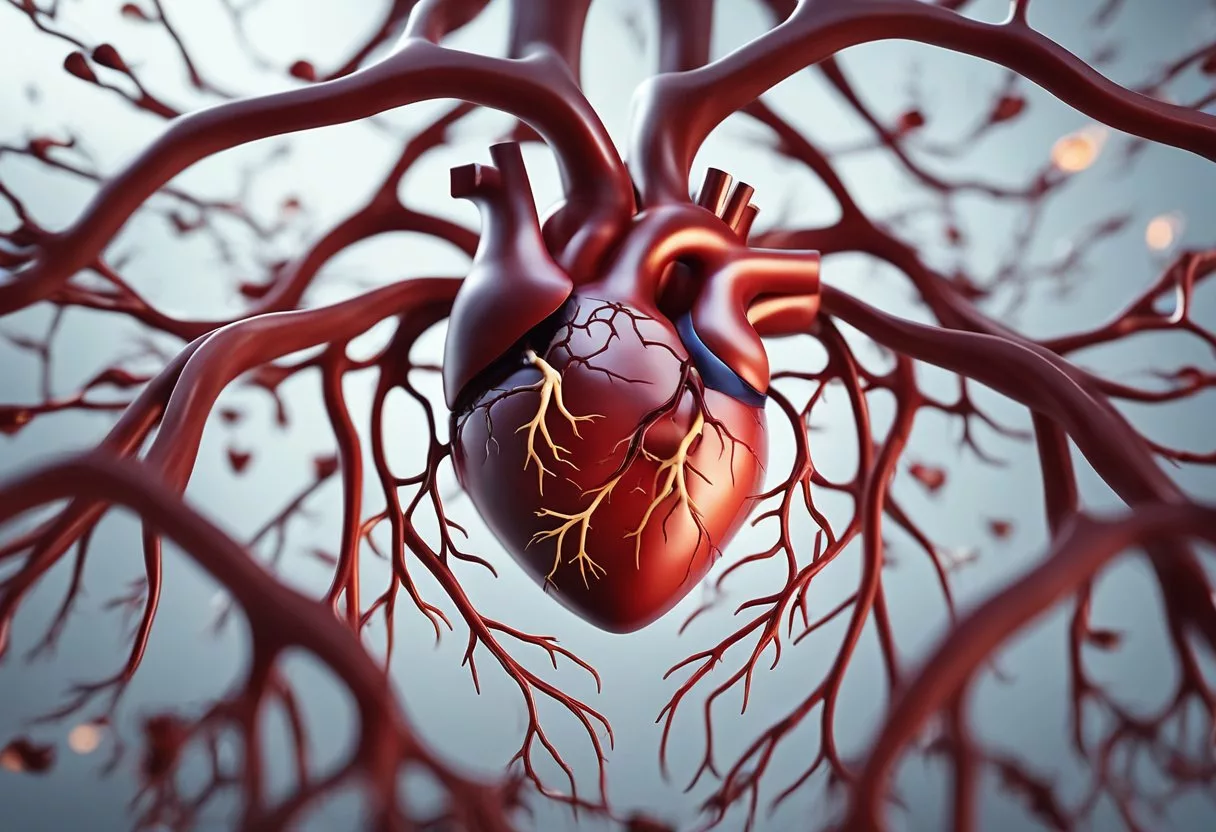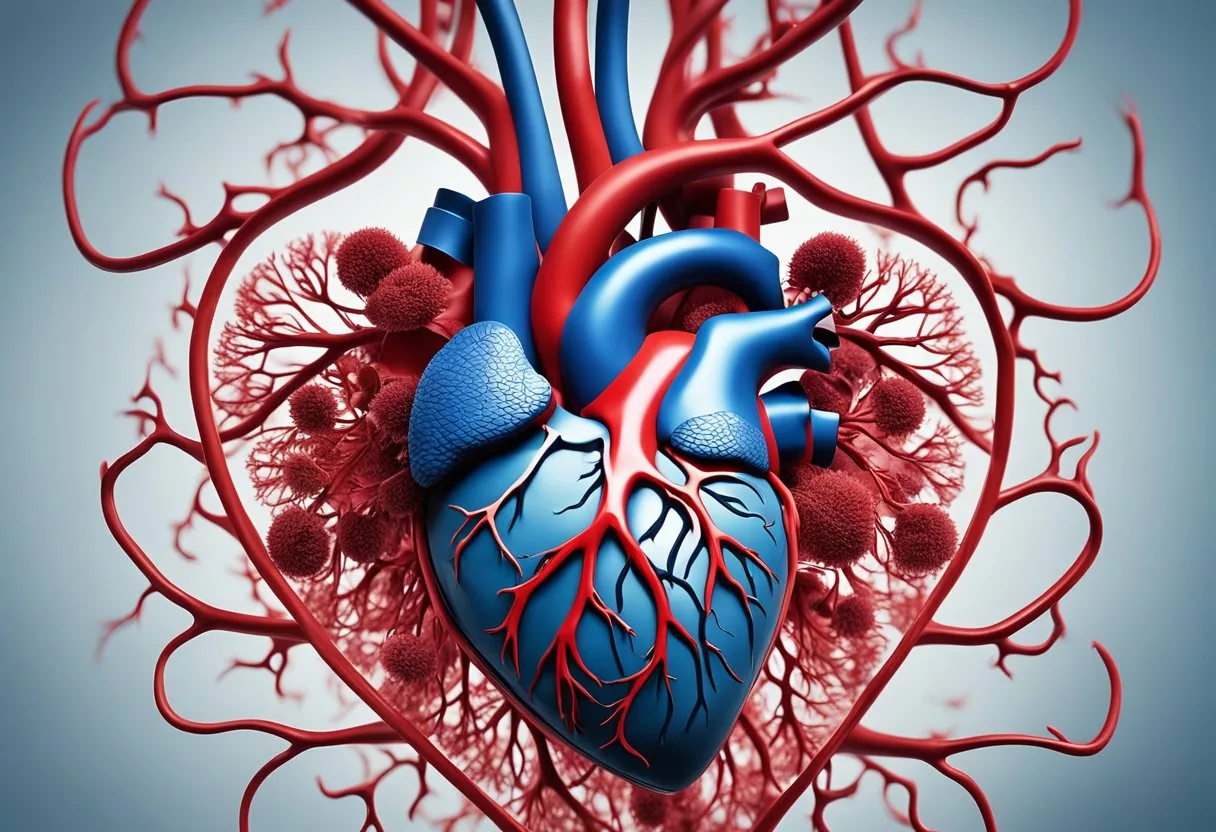Cardiovascular health is a crucial aspect of overall well-being, affecting millions of people globally. Maintaining good cardiovascular health can prevent serious problems such as heart attacks and strokes, which are the leading causes of death worldwide. The cardiovascular system, comprising the heart and blood vessels, ensures the body gets the oxygen and nutrients it needs to function properly.

There are many risk factors for cardiovascular disease, including high blood pressure, high cholesterol, smoking, and a sedentary lifestyle. Symptoms of cardiovascular issues can range from chest pain and shortness of breath to dizziness and fatigue. Early diagnosis and treatment can make a significant difference in outcomes.
Preventative measures include a healthy diet, regular exercise, and avoiding tobacco products. Medical intervention may be necessary for those already experiencing cardiovascular issues. Understanding the importance of cardiovascular health and taking proactive steps can help individuals lead longer, healthier lives.
Key Takeaways
- Maintaining cardiovascular health prevents serious issues like heart attacks.
- Symptoms include chest pain, shortness of breath, and dizziness.
- Healthy lifestyle choices and early treatment improve outcomes.
Understanding Cardiovascular Health

Cardiovascular health is essential for the body’s overall function. It involves the anatomy of the cardiovascular system and the role of the heart and blood vessels in maintaining blood flow.
Anatomy of the Cardiovascular System
The cardiovascular system consists of the heart, blood, and blood vessels. The heart is a muscular organ with four chambers: two atria and two ventricles. It pumps blood through the body.
There are three types of blood vessels: arteries, veins, and capillaries. Arteries carry oxygen-rich blood away from the heart. Veins return oxygen-poor blood back to the heart. Capillaries are tiny vessels where the exchange of oxygen and nutrients with tissues occurs.
The structure of the heart includes three layers: the epicardium, myocardium, and endocardium. These layers support the heart’s function and provide a protective barrier.
Role of the Heart and Blood Vessels
The heart’s primary role is to pump blood. It ensures that oxygen and nutrients reach all parts of the body. Heart valves prevent the backflow of blood and maintain a one-way flow through the heart’s chambers.
Blood flow begins in the right atrium, moves to the right ventricle, and then travels to the lungs to get oxygen. Oxygenated blood returns to the left atrium, moves into the left ventricle, and is then pumped through the aorta to the rest of the body.
Blood vessels are crucial for transporting blood. Arteries deliver oxygen-rich blood from the heart to tissues. Veins carry deoxygenated blood back to the heart. Capillaries facilitate the exchange of oxygen, carbon dioxide, and nutrients between blood and tissues.
Risk Factors and Causes

Cardiovascular diseases result from both lifestyle choices and genetic factors. Understanding these aspects can help in preventing and managing heart conditions effectively.
Lifestyle and Cardiovascular Diseases
Lifestyle choices significantly influence heart health. Smoking is a major risk factor as it damages blood vessels, leading to heart disease. High blood pressure, often linked to diet and lack of exercise, strains the heart. Similarly, high cholesterol clogs arteries, increasing the risk of heart attacks and strokes.
Obesity and lack of physical activity are closely related. Being overweight puts extra strain on the heart, and a sedentary lifestyle can lead to weight gain and other health issues like diabetes. Diabetes, if not managed well, can damage blood vessels and the heart over time. High stress levels also contribute to heart disease, often exacerbating other risk factors. Alcohol and tobacco use further harm cardiovascular health, creating a dangerous mix of problems.
Key Risk Factors:
- Smoking
- High blood pressure
- High cholesterol
- Diabetes
- Obesity
- Physical inactivity
- Stress
- Alcohol and tobacco use
Genetic and Congenital Factors
Genetic predispositions also play a crucial role. Family history of heart disease increases the likelihood of developing cardiovascular conditions. Age is an important factor; risk increases as individuals grow older. Men are generally at higher risk than women, though post-menopausal women’s risk also rises.
Some people are born with congenital heart defects. These defects can affect normal heart function and increase the risk of developing cardiovascular diseases later in life. While lifestyle changes can mitigate some risks, genetic factors often require medical monitoring and intervention for effective management.
Key Genetic Factors:
- Family history
- Age
- Gender differences
- Congenital heart defects
Both lifestyle and genetic factors crucially determine cardiovascular health. Addressing these through lifestyle changes and medical care can significantly reduce the risk of heart diseases.
Common Cardiovascular Conditions

Cardiovascular conditions can significantly impact health. Common conditions include coronary artery disease, hypertension, stroke, arrhythmias, and valve diseases.
Coronary Artery Disease and Complications
Coronary artery disease (CAD) happens when the coronary arteries become narrow or blocked, typically due to atherosclerosis. This condition can lead to a heart attack if blood flow to the heart muscle is severely reduced or cut off. Angina is another symptom, characterized by chest pain due to reduced blood flow. Heart failure, where the heart can’t pump blood effectively, can also result from extended CAD. CAD is one of the primary causes of cardiovascular disease worldwide, leading to significant health concerns.
Hypertension and Stroke
Hypertension, or high blood pressure, is a major risk factor for stroke. Over time, high blood pressure can damage artery walls, making them more prone to blockages or ruptures. Ischemic strokes occur when a blood clot obstructs an artery supplying the brain, leading to brain cell death. In contrast, hemorrhagic strokes happen when an artery in the brain bursts, causing bleeding. These strokes can lead to severe disability or death, highlighting the importance of managing blood pressure effectively.
Arrhythmias and Valve Disease
Arrhythmias are conditions where the heart beats irregularly, too fast (tachycardia), or too slow (bradycardia). These abnormal heart rhythms can affect the heart’s ability to pump blood effectively. Valve disease involves malfunctioning heart valves, where they may become narrowed (stenosis) or leak (regurgitation). Both conditions can lead to symptoms like shortness of breath, fatigue, and chest pain. Congenital heart disease, a defect present at birth, can also involve valve abnormalities, affecting long-term cardiovascular health. Getting timely treatment for arrhythmias and valve diseases is crucial to prevent complications.
Symptoms and Diagnosis

Understanding the key symptoms of cardiovascular disease and the methods used for diagnosis is crucial for early detection and treatment. These symptoms often include chest pain, shortness of breath, and fatigue. Diagnostic tests like electrocardiograms and echocardiograms are essential tools used by healthcare providers.
Recognizing Cardiovascular Symptoms
Cardiovascular symptoms can vary widely but often include chest pain or discomfort (angina). This pain may feel like pressure, heaviness, or tightness in the chest. Shortness of breath is another common symptom, especially during physical activity or rest.
Other symptoms include fatigue, which is a persistent feeling of tiredness, and swelling in the legs, ankles, or feet due to fluid buildup. Dizziness, nausea, and fainting (syncope) are also observed in some cases. Symptoms like numbness or weakness in the legs and arms can occur if blood flow is restricted.
It’s essential to recognize these signs early and seek medical attention if they occur. This can help prevent severe complications and improve outcomes.
Diagnostic Tests and Procedures
A variety of diagnostic tests are used to identify cardiovascular diseases. An electrocardiogram (EKG or ECG) is a common test that measures the electrical activity of the heart and can help detect irregular heartbeats or damage. An echocardiogram uses ultrasound waves to create images of the heart, showing its structure and function.
A stress test involves exercising on a treadmill or stationary bike while heart activity is monitored, helping to identify problems that occur under physical stress. Other diagnostic tools include blood tests to measure cholesterol and other markers of heart disease, and angiography, which uses X-ray imaging to visualize blood flow in the arteries.
These tests are critical for diagnosing and managing cardiovascular conditions effectively. Healthcare providers use them to determine the best course of treatment for patients.
Treatment and Management

Managing cardiovascular health involves a combination of medications, surgical procedures, and lifestyle adjustments. Here are the key aspects of treatment and management.
Medical Treatments and Medications
Medical treatments often include medications like beta-blockers, statins, and blood thinners. Beta-blockers help reduce blood pressure and heart rate. Statins are used to lower high cholesterol levels, which can prevent plaque buildup in the arteries.
In addition, aspirin or other blood-thinning drugs might be prescribed to reduce blood clot risks. Managing heart conditions through medication requires regular monitoring and adjusting doses as needed. Patients may also be advised to take medications for high blood pressure, such as ACE inhibitors.
Surgical Interventions
Some cases require surgical procedures. Angioplasty is a common procedure where a balloon is used to open clogged arteries. A stent may be placed to keep the artery open. For more severe blockages, coronary artery bypass grafting (CABG) reroutes blood flow around a blocked artery.
Pacemakers might be used for irregular heartbeats, helping maintain a steady rhythm. These surgical interventions are essential for preventing heart attacks and improving the patient’s quality of life.
Lifestyle Management and Rehabilitation
Lifestyle changes are critical for managing cardiovascular health. A healthy diet, low in saturated fat and high in fruits and vegetables, helps maintain healthy cholesterol levels. Regular physical activity like walking, swimming, or cycling strengthens the heart and helps with weight management.
Cardiac rehabilitation programs offer structured exercise and education about lifestyle changes. These programs support recovery and encourage long-term habits to reduce risks of future heart problems. Maintaining a healthy weight and avoiding unhealthy diets are vital steps in this process.
Prevention and Healthy Living

Taking steps to prevent cardiovascular disease involves a combination of healthy eating and regular physical activity. A balanced diet and maintaining an active lifestyle can significantly reduce the risks associated with heart disease.
Dietary Approaches and Nutrition
Choosing healthy foods is crucial for heart health. It’s important to eat plenty of fresh fruits and vegetables while limiting processed foods. Foods high in saturated fats and trans fats can increase cholesterol levels, which may contribute to heart disease. Opting for foods high in fiber and low in these harmful fats is beneficial.
Whole grains, nuts, legumes, and seeds should be part of the diet. Oily fish like salmon or mackerel, eaten at least twice a week, can provide essential omega-3 fatty acids. Lower fat dairy products and skinless poultry are better choices for reducing saturated fat intake.
Limiting sugar-sweetened beverages and red meat intake can also help maintain a heart-healthy diet. Such dietary changes can lead to lower cholesterol and reduced risk of heart disease.
Exercise and Weight Management
Regular physical activity is essential for maintaining a healthy heart. Aim for at least 30 to 60 minutes of moderate exercise each day. Activities like walking, jogging, swimming, or biking can help manage weight and reduce obesity, which is a significant risk factor for cardiovascular disease.
Exercise helps control weight by burning calories and improving cardiovascular fitness. It also lowers blood pressure and reduces the risk of developing other conditions that strain the heart.
Incorporating physical activity into daily routines can improve both short-term and long-term heart health. Making lifestyle changes, like taking the stairs instead of the elevator or joining a sports team, can make staying active more enjoyable and sustainable. Regular exercise paired with a healthy diet can dramatically improve cardiovascular health.
Outlook and Progression

In recent years, there has been a notable decrease in age-adjusted death rates from cardiovascular disease (CVD) due to significant advancements in prevention and treatment. Since the 1960s, these rates have declined by more than 70% (source).
Long-term management of CVD is crucial as it remains the leading cause of death in the United States, accounting for over 800,000 deaths annually (source). Effective management includes medication, lifestyle changes, and regular medical check-ups.
Chronic conditions like high blood pressure and high cholesterol significantly contribute to CVD. By 2030, it is projected that 40.5% of the US population will have some form of CVD (source). This increase underscores the importance of ongoing management and preventative measures.
Aging populations face higher risks due to natural physiological changes. Age-specific strategies are essential to address the unique challenges faced by older adults. For example, tailored exercise programs and dietary plans can help manage risks.
Advancements in medical technology and treatment options continue to evolve. Improved diagnostic tools, innovative medications, and personalized treatment plans are all contributing to better outcomes for patients.
Outlook for cardiovascular health also involves addressing socio-economic and environmental factors. Access to healthcare, education on healthy living, and supportive community programs can make a significant difference.
In summary, ongoing progress in medical science, combined with comprehensive long-term management strategies, presents a hopeful outlook for individuals with cardiovascular conditions.
Frequently Asked Questions
Cardiovascular disease (CVD) includes a range of conditions affecting the heart and blood vessels. Understanding the common types, causes, symptoms, and treatments can help manage and prevent these conditions.
What are the most common types of cardiovascular disease?
The most prevalent types of CVD are coronary artery disease, heart failure, and arrhythmias.
These conditions can lead to heart attacks, strokes, and other serious health issues.
What are the main causes of cardiovascular disease?
Major causes include high blood pressure, high cholesterol, and diabetes.
Smoking, obesity, and lack of exercise also contribute significantly. Family history plays a role, and certain conditions during pregnancy can also increase risk.
What lifestyle changes can help prevent cardiovascular disease?
Key lifestyle changes include eating a balanced diet, exercising regularly, and maintaining a healthy weight.
Quitting smoking and reducing alcohol consumption are also important. Regular check-ups with a healthcare provider help in early identification and management of risk factors.
What symptoms may indicate the presence of cardiovascular disease?
Common symptoms include chest pain, shortness of breath, and rapid heartbeat.
Other signs can be nausea, fatigue, and pain in areas like the jaw or upper back, especially in women.
What are the current treatment options for cardiovascular disease?
Treatment options vary and may include medications like statins, lifestyle changes, and surgical procedures.
Stents and bypass surgery are common for blocked arteries. Medications are used to manage blood pressure, cholesterol, and other conditions.
What are the risk factors associated with cardiovascular disease?
Risk factors include age, family history, and existing health conditions like high blood pressure and diabetes.
Lifestyle factors like diet, activity level, and smoking habits also play a significant role. Gender and certain ethnic backgrounds influence risk levels too.